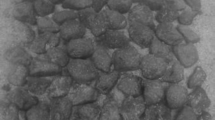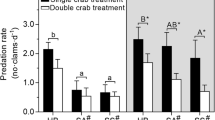Abstract
The attractiveness of shelters and the relationship between crayfish size and refuge size were investigated in the stone crayfish Austropotamobius torrentium. Shelter suitability was mainly determined by water velocity, stone surface area and stone width. Water depth and stone height had no influence on crayfish occupancy of stones. Austropotamobius torrentium avoided shelters in areas of water velocities exceeding 25 cm s−1. They preferred large stones with a bearing surface greater than 300 cm2. The probability of crayfish occupation rose quickly as stones' bearing surface increased up to 900 cm2. Crayfish were exclusively caught underneath stones at least 3.19 times longer and 1.25 times wider than the carapace length of the refuge occupant. Large males occupied larger stones, where no relationship was detected between female size and stone refuge size.
Similar content being viewed by others
References
Blake, M. A. & J. B. Hart, 1993. Habitat preferences and survival of juvenile signal crayfish, Pacifastacus leniusculus–the influence of water depth, substratum, predatory fish and gravid female crayfish. Freshw. Crayfish 9: 381–384.
Bohl, E., 1989. Ökologische Untersuchungen an ausgewählten Gewässern zur Entwicklung von Zielvorstellungen des Gewässerschutzes. Bayerische Landesanstalt für Wasserforschung, Wielenbach: 237 pp.
Ellenberg, H., 1986. Vegetation Mitteleuropas mit den Alpen in ökologischer Sicht. 4. Auflage. Ulmer, Stuttgard: 989 pp.
Englund, G. & J. J. Krupa, 2000. Habitat use by crayfish in stream pools: influence of predators, depth and body size. Freshwat. Biol. 43: 75–83.
Eversole, A. G. & J. W. Foltz, 1993. Habitat relationships of two crayfish species in a mountain stream. Freshw. Crayfish 9: 300–310.
Foster, J., 1990. Factors influencing the distribution and abundance of the crayfish Austropotamobius pallipes in Wales and the Marches, U.K. Freshw. Crayfish 8: 78–98.
Foster, J., 1993. The relationship between refuge size and body size in the crayfish Austropotamobius pallipes (Lereboullet). Freshw. Crayfish 5: 254–267.
Gamperl, R., 1990. Vorkommen und Verbreitung von Flusskrebsen (Astacidae) in den Gewässern der Steiermark. PhD Thesis, Univ. Graz, Austria: 120 pp.
Hogger, J. B., 1988. Ecology, population biology and behaviour. In Holdich, D. M. & R. S. Lowery (eds), Freshwater Crayfish: Biology, Management and Exploitation. Chapman & Hall, London: 114–144.
Hosmer, D. J. & S. Lemeshow, 1989. Applied Logistic Regression. Wiley and Sons, New York: 307 pp.
Jordan, F., C. J. De Leon & A. C. Mc Creary, 1996. Predation, habitat complexity and distribution of the crayfish Procambarus alleni within a wetland habitat mosaic. Wetlands 4: 452–457.
Klosterman, B. J. & C. R. Goldman, 1981. Substrate selection behaviour of the crayfish Pacifastacus leniusculus. Freshw. Crayfish 5: 254–265.
Kutka, F. J., C. Richards & G. W. Merrick, 1996. Habitat relationships and distribution of the crayfish, Orconectes propinquus, in the Saint Louis River Basin, Minnesota, U.S.A. Freshw. Crayfish 11: 73–82.
Laurent, P. J., 1988. Austropotamobius pallipes and A. torrentium, with observations on their interaction with other species in Europe. In Holdich, D. M. & R. S. Lowery (eds), Freshwater Crayfish: Biology, Management and Exploitation. Chapman & Hall, London: 341–364.
Levenbach, S. & B. A. Hazlett, 1996. Habitat displacement and the mechanical and display functions of chelae in crayfish. J. Freshw. Ecol. 4: 485–492.
Mason, J. C., 1979. Effects of temperature, photoperiod, substrate and shelter on survival, growth and biomass accumulation of juvenile Pacifastacus leniusculus in culture. Freshw. Crayfish 4: 73–82.
Niemi, A., 1977. Population studies on the crayfish Astacus astacus (L.) in the river Pyhäjeki, Finland. Freshw. Crayfish 3: 81–94.
Payne, J. F., 1984. Factors influencing patterns of crayfish distribution. Freshw. Crayfish 7: 100–110.
Pretzmann, G., 1994. Rote Liste der Zehnfüßigen Krebse (Decapoda) und Schwebgarnelen (Mysidacea) Österreichs. In Gepp, J. (ed.), Rote Listen gefährdeter Tiere Österreichs. Bundesministerium für Gesundheit und Umweltschutz, Vienna: 279–281.
Schulz, N. & W. Kirchlehner, 1984. Der Steinkrebsbestand Astacus torrentium (Schrank) im Spintikbach (Kärnten, Österreich). Österreichs Fischerei 37: 47–57.
Troschel, H. J., 1997. Distribution and ecology of Austropotamobius pallipes in Germany. Bull. Fr. Peche Piscic. 347: 639–647.
Troschel, H. J. & P., Dehus, 1993. Distribution of crayfish species in the Federal Republic of Germany, with special reference to Austropotamobius pallipes. Freshw. Crayfish 9: 390–398.
Vorburger, C. & G. Ribi, 1999. Aggression and competition for shelter between a native and an introduced crayfish in Europe. Freshw. Biol. 42: 111–119.
Wintersteiger, M., 1985. Flusskrebse in Österreich. Studie zur gegenwärtigen Verbreitung der Flusskrebse in Österreich und zu den Veränderungen ihrer Verbreitung seit dem Ende des 19. Jahrhunderts. Ergebnisse limnologischer und astacologischer Untersuchungen an Krebsgewässern und Krebsbeständen. PhD Thesis, Univ. Salzburg, Austria: 180 pp.
Wahle, R. A. & R. S. Steneck, 1992. Habitat restrictions in early benthic life: experiments on habitat selection and in situ predation with the American lobster. J. exp. mar. Biol. Ecol. 157: 91–114.
Westin, L. & R. Gydemo, 1988. The locomotor activity patterns of juvenile Noble Crayfish (Astacus astacus) and the effect of shelter availability. Aquaculture 68: 364–367.
Author information
Authors and Affiliations
Rights and permissions
About this article
Cite this article
Streissl, F., Hödl, W. Habitat and shelter requirements of the stone crayfish, Austropotamobius torrentium Schrank. Hydrobiologia 477, 195–199 (2002). https://doi.org/10.1023/A:1021094309738
Issue Date:
DOI: https://doi.org/10.1023/A:1021094309738




